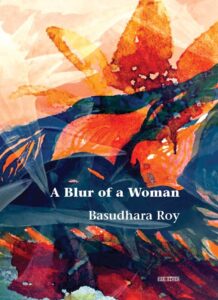
A Blur of a Woman by Basudhara Roy (Red River 2024)
Reviewed by Ajmira Khatun
Hey dear!
Let me take you on a ride! And explore “A Blur of a Woman” by Basudhara Roy together.
It’s a journey of voice and silence. With each verse, Roy leads us through milestones of memory, resistance, longing, and truth. Her words don’t just speak — they burn, breathe, and bare.
So are you ready? Shall we go then?
…
Look over there! At the first milestone, she called it “Childhood Dream.”
One who sat beside my window on a train
confessed I smelt of milk, and did I know that?
I am mostly afraid of what you will smell on my skin,
of what you will say. I fear the din, this uneven place in my head.
See how delicately she captures childhood? Yet, she also paints how even innocence is not safe. Right?
The dream becomes a soft, surreal space where memory and fear hold hands. Through the scent of milk, a symbol of youth and purity, she reveals how even the earliest stages of girlhood are suppressed by “blue jhumkaas.”
…
Have you ever seen a house built from grief, memory, and emotions? If you want to understand, take a look at the second milestone known as “The Dark House.”
these rooms were built to hold grief
This house changes shape, glows with floating specks of light. And then, in the final image, Roy unlocks the attic, and shows them a moon,
perched like a pendant
on the dark’s clavicle
is an immense edible moon.
…
Feeling bored? How about we enjoy a beautiful ghazal together beneath a monsoon sky? Let me share one with you — “A Ghazal in Me.”
When I dreamed a dream’s dream in me
Its light left the universe to gleam in me…
Everywhere truth jeers through a hundred lies.
Does Draupadi’s gory hair still scream in me?
Break not a rosary that a faith has been lost
There are yet greater gods to redeem in me.
Uff! How beautiful!
…
Do you know what Roy lives with? Let’s explore another milestone – “What I live with.”
Take a deep breath at first and start…
children husband parents poetry plants
cell-phone laptop camera music zumba
obesity thyroid diabetes hypertension
hair-loss friends finances god
indifference forgetting spine-ache neglect
deadlines rejection-letters sleeplessness memory
The daily life of a woman is often shaped by a complex tapestry of identities and responsibilities, each contributing to her unique experience. This intricate rhythm can feel overwhelming at times, yet it also highlights her incredible strength and capacity to adapt.
And then, at the end, comes and softest blow:
when the clock chimes your hour and you fail to arrive…
…
We’re excited to be getting closer to our next milestone, which she has called “The Last Laugh!”
Here we explore the quiet, everyday imbalance between a man and a woman. The woman is observant and emotionally present —
When she is gazing at the hills — while the man mocks her distraction:
he half-smirks over the milk that has boiled and walked out
under her very nose.
Even her pain is analyzed clinically:
The blood in her words
he reads clinically. Monocytes lymphocytes neutrophils
seem fine to him.
Roy illustrates how patriarchal society often belittles women when they show vulnerability. Yet the poem ends not with despair, but with subtle power:
The woman always finds a door.
The man always thinks what a fool she is.
Time always has the last laugh.
…
Hey, dear!
There are still so many milestones left on this journey — there’s the aching honesty of “Duhkha” and the quiet devastation of “World’s End.” In “Soka,” grief is etched in striking imagery, while in “Lalita Speaks,” a mythological voice rises from silent words. Then there’s “Re-(pre)sent-a-tion/s,” where the poem almost fractures. “Six Ways to Kill a Poem” is sharp, satirical, while “Praise for the Subaltern” turns our gaze to the overlooked and unheard. Even in something as deceptively sweet as “Coconut Laddu,” Roy weaves memory, ritual, and womanhood into something far richer than nostalgia. And just when we think we’ve reached the end,
“Author’s Note: I Write From the Body” arrives like a whispered manifesto!
…
Would you like to ride more, dear? The weather is so lovely, so we can go to the last milestone and then head back. Is that okay with you?
Let’s explore the one that bears the name of the entire journey: “A Blur of a Woman”. And think! What a place to pause. Isn’t it?
See the woman is not named, not even clearly seen. She is fading and constant at once — a presence held together by effort, by duty, by the stubborn act of being.
She is rumour sliding down the grapevine
paint running off with rain
plaster peeling from wall
bark from tree
nostalgia from past.
Though “more potent wills have overruled,” she “has stood her ground / defending quietly all day / her one foothold of land.”
She doesn’t fight — she vanishes. Not in defeat, but in quiet mastery.
She will use it someday to unbuild herself
disappear dissolve
become a blur.
…
Shall we stop and return now, dear?
I know this journey has left us breathless. It’s not just a journey that speaks; it resonates deeply, inviting us to feel, remember, and move through the ‘blur.’
You say, “It’s too much, all these milestones” and I reply, softly, through her words:
as one flows
flawed flamed fearless free.